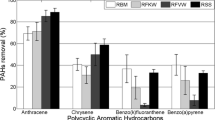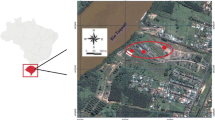Abstract
This study investigates the importance of the organic matter characteristics of several organic amendments (i.e., buffalo manure, food and kitchen waste, fruit and vegetables waste, and activated sewage sludge) and their influence in the bioremediation of a polycyclic aromatic hydrocarbons (PAH)-contaminated soil. The removal of low molecular weights (LMW) and high molecular weights (HMW) PAHs was monitored in four bioremediation reactors and used as an indicator of the role of organic amendments in contaminant removal. The total initial concentration of LMW PAHs was 234 mg kg−1 soil (dry weight), while the amount for HMW PAHs was 422 mg kg−1 soil (dry weight). Monitoring of operational parameters and chemical analysis was performed during 20 weeks. The concentrations of LMW PAH residues in soil were significantly lower in reactors that displayed a mesophilic phase, i.e., 11 and 15 %, compared to reactors that displayed a thermophilic phase, i.e., 29 and 31 %. Residual HMW PAHs were up to five times higher compared to residual LMW PAHs, depending on the reactor. This demonstrated that the amount of added organic matter and macronutrients such as nitrogen and phosphorus, the biochemical organic compound classes (mostly soluble fraction and proteins), and the operational temperature are important factors affecting the overall efficiency of bioremediation. On that basis, this study shows that characterization of biochemical families could contribute to a better understanding of the effects of organic amendments and clarify their different efficiency during a bioremediation process of PAH-contaminated soil.




Similar content being viewed by others
References
Ankom Technology (2015a) Analytical Methods [WWW Document]. https://www.ankom.com/analytical-methods-support/fiber-analyzer-a2000. Accessed 6 Dec 2015
Ankom Technology (2015b) http://www.google.fr/url?sa=t&rct=j&q=&esrc=s&source=web&cd=1&ved=0CCEQFjAA&url=http%3A%2F%2Fwww.catherinecardelus.com%2Fankom_protocol-2.doc&ei=HrY_VcH5F4L8aP34gXA&usg=AFQjCNEdB-xVt8KMRqqryd1PcS6jzcYVag&bvm=bv.91665533,d.d2s. Accessed 28 April 2015.
Antizar-Ladislao B, Lopez-Real J, Beck AJ (2005) In-vessel composting-bioremediation of aged coal tar soil: effect of temperature and soil/green waste amendment ratio. Environ Int 31:173–178. doi:10.1016/j.envint.2004.09.012
APHA American Public Health Association (APHA), American Water Works Association (AWWA), Water Environment Federation (WEF), 1998. Chemical oxygen demand (COD), 5220 D Closed Reflux, Colorimetric method in: Standard methods for the examination of water and wastewater
ASTM American Society for Testing and Materials, 1999. Standard Test Method for Laboratory Determination of Water (Moisture) Content of Soil and Rock by Mass. Designation: D 2216 – 98
Atagana HI, Haynes RJ, Wallis FM (2003) Co-composting of soil heavily contaminated with creosote with cattle manure and vegetable waste for the bioremediation of creosote-contaminated Soil. An Int. J. 885–899
Bamforth SM, Singleton I (2005) Bioremediation of polycyclic aromatic hydrocarbons: current knowledge and future directions. J Chem Technol Biotechnol 80:723–736. doi:10.1002/jctb.1276
Bergknut M (2006) Characterization of PAH-contaminated soils focusing on availability, chemical composition and biological effects. PhD thesis pp. 58, Umeå University
Bot A, Benites J (2005) The importance of soil organic matter, Key to drought-resistant soil and sustained food production, FAO Soils Bulletin. Food and Agriculture Organization of the United Nations. doi:10.1080/03650340214162
Brinch UC, Ekelund F, Jacobsen CS (2002) Method for Spiking Soil Samples with Organic Compounds. Appl. Environ. Microbiol. 68. doi:10.1128/AEM.68.4.1808
Dreyer A, Radke M, Turunen J, Blodau C (2005) Long-term change of polycyclic aromatic hydrocarbon deposition to peatlands of eastern Canada. Environ Sci Technol 39:3918–3924
Dulekgurgen E (2004) Proteins Protocol 2 Lowry solution [WWW Document]. UIUC. URL http://web.itu.edu.tr/~dulekgurgen/Proteins.pdf . Accessed 22 May 2015
Eom IC, Rast C, Veber AM, Vasseur P (2007) Ecotoxicity of a polycyclic aromatic hydrocarbon (PAH)-contaminated soil. Ecotoxicol Environ Saf 67:190–205. doi:10.1016/j.ecoenv.2006.12.020
Fernández-Luqueño F, Marsch R, Espinosa-Victoria D, Thalasso F, Hidalgo Lara ME, Munive A, Luna-Guido ML, Dendooven L (2008) Remediation of PAHs in a saline-alkaline soil amended with wastewater sludge and the effect on dynamics of C and N. Sci Total Environ 402:18–28. doi:10.1016/j.scitotenv.2008.04.040
Gan S, Lau EV, Ng HK (2009) Remediation of soils contaminated with polycyclic aromatic hydrocarbons (PAHs). J Hazard Mater 172:532–549. doi:10.1016/j.jhazmat.2009.07.118
Guerin TF (2000) The differential removal of aged polycyclic aromatic hydrocarbons from soil during bioremediation. Environ Sci Pollut Res 7:19–26. doi:10.1065/espr199910.004
Haderlein A, Legros R, Ramsay BA (2006) Pyrene mineralization capacity increases with compost maturity. Biodegradation 17:293–302. doi:10.1007/s10532-005-4217-8
Hood EE, Nelson P, Powell R (2011) Plant Biomass Conversion [WWW Document]. URL https://books.google.com/books?id=EHUq5W_ZEkMC&pgis=1. Accessed 28 April 2015
Janssen I, Koopmann R (2005) Determination of Kjeldahl Nitrogen in soil, biowaste and sewage sludge. CEN/BT/Task Force 151 – Horiz. Stand. held by Danish Stand
Joseph PJ (2007) Bioremediation of petroleum sludge through Phytoremediation, Land farming and Microbial enhanced oil separation. PhD thesis pp. 157, Cochin University of Science and Technology
Leys NM, Bastiaens L, Verstraete W, Springael D (2005) Influence of the carbon/nitrogen/phosphorus ratio on polycyclic aromatic hydrocarbon degradation by Mycobacterium and Sphingomonas in soil. Appl Microbiol Biotechnol 66:726–736. doi:10.1007/s00253-004-1766-4
Ling CC, Isa MH (2006) Bioremediation of oil sludge contaminated soil by co-composting with sewage sludge. J Sci Ind Res (India) 65:364–369
McDowell D, Maloney M, Swan L, Erwin P (2007) A Review of the Fruit and Vegetable Food Chain [WWW Document]. URL http://www.safefood.eu/Publications/Research-reports/Fruit-and-Vegetables.aspx. Accessed 29 October 2014
McKenzie L (2015) Metabolism: nitrogen - biochemistry | Fastbleep [WWW Document]. URL http://www.fastbleep.com/biology-notes/40/116/753. Accessed 28 April 2015
Mohan SV, Kisa T, Ohkuma T, Kanaly RA, Shimizu Y (2006) Bioremediation technologies for treatment of PAH-contaminated soil and strategies to enhance process efficiency. Rev Environ Sci Biotechnol 5:347–374. doi:10.1007/s11157-006-0004-1
Namkoong W, Hwang EY, Park JS, Choi JY (2002) Bioremediation of diesel-contaminated soil with composting. Environ Pollut 119:23–31. doi:10.1016/S0269-7491(01)00328-1
Nduka JK, Umeh LN, Okerulu IO, Umedum LN, Okoye HN (2012) Utilization of Different Microbes in Bioremediation of Hydrocarbon Contaminated Soils Stimulated With Inorganic and Organic Fertilizers. J. Pet. Environ. Biotechnol. 03. doi:10.4172/2157-7463.1000116
OECD/OCDE 317 (2010) OECD Guidelines for the testing of chemicals. doi:10.1787/9789264090934-en
Okere UV, Semple KT (2012) Biodegradation of PAHs in “pristine” soils from different climatic regions. J Bioremediation Biodegrad 01:1–11. doi:10.4172/2155-6199.S1-006
Pansu M, Gautheyrou J (2006) Handbook of soil analysis mineralogical, organic and inorganic methods. Springer, Berlin Heidelberg
Picado A, Nogueira A, Baeta-Hall L, Mendonça E, de Fátima Rodrigues M, do Céu Sàágua M, Martins A, Anselmo AM (2001) Landfarming in a PAH-contaminated soil. J Environ Sci Heal A36:1579–1588. doi:10.1081/ESE-100106243
Pu X, Cutright TJ (2006) Sorption–desorption behavior of PCP on soil organic matter and clay minerals. Chemosphere 64:972–983. doi:10.1016/j.chemosphere.2006.01.017
Rhodes AH, Hofman J, Semple KT (2008) Development of phenanthrene catabolism in natural and artificial soils. Environ Pollut 152:424–430. doi:10.1016/j.envpol.2007.06.072
Sawada A, Kanai K, Fukushima M (2004) Preparation of artificially spiked soil with polycyclic aromatic hydrocarbons for soil pollution analysis. Anal Sci 20:239–241. doi:10.2116/analsci.20.239
Sayara T, Sarrà M, Sánchez A (2010) Effects of compost stability and contaminant concentration on the bioremediation of PAHs-contaminated soil through composting. J Hazard Mater 179:999–1006. doi:10.1016/j.jhazmat.2010.03.104
Sayara T, Borràs E, Caminal G, Sarrà M, Sánchez A (2011) Bioremediation of PAHs-contaminated soil through composting: influence of bioaugmentation and biostimulation on contaminant biodegradation. Int Biodeterior Biodegrad 65:859–865. doi:10.1016/j.ibiod.2011.05.006
Thassitou PK, Arvanitoyannis IS (2001) Bioremediation: a novel approach to food waste management. Trends Food Sci Technol 12:185–196. doi:10.1016/S0924-2244(01)00081-4
U. S. Environmental Protection Agency (1994) Chapter V Landfarming [WWW Document]. URL http://www.epa.gov/oust/pubs/tum_ch5.pdf . Accessed 22 January 2015
U. S. Environmental Protection Agency (2012a) Method 9045D soil and waste pH [WWW Document]. URL http://www.epa.gov/osw/hazard/testmethods/sw846/online/9_series.htm. Accessed 14 October 2014
U. S. Environmental Protection Agency (2012b) Method 3546 microwave extraction [WWW Document]. URL http://www.epa.gov/osw/hazard/testmethods/sw846/online/3_series.htm. Accessed 14 October 2014
U. S. Environmental Protection Agency (2012c) Method 8270D semivolatile organic compounds by gas chromatography/mass spectrometry (GC/MS) [WWW Document]. URL http://www.epa.gov/osw/hazard/testmethods/sw846/online/8_series.htm. Accessed 14 October 2014
Van Gestel K, Mergaert J, Swings J, Coosemans J, Ryckeboer J (2003) Bioremediation of diesel oil-contaminated soil by composting with biowaste. Environ Pollut 125:361–368. doi:10.1016/S0269-7491(03)00109-X
Van Soest PJ (1963) Use of detergents in the analysis of fibrous feeds II. A rapid method for the determination of fiber and lignin. J Assoc Official Agric Chem 46:829–835
Wick FA, Haus WN, Sukkariyah FB, Haering CK, Daniels LW (2011) Remediation of PAH-contaminated soils and sediments: a literature review [WWW Document]. URL http://landrehab.org/ Accessed 12 November 2014
Acknowledgments
The authors would like to acknowledge the financial support provided by the European Commission (Erasmus Mundus Joint Doctorate Programme ETeCoS3: Environmental Technologies for Contaminated Solids, Soils and Sediments, under the grant agreement FPA no. 2010–0009).
Author information
Authors and Affiliations
Corresponding author
Additional information
Responsible editor: Philippe Garrigues
Rights and permissions
About this article
Cite this article
Lukić, B., Huguenot, D., Panico, A. et al. Importance of organic amendment characteristics on bioremediation of PAH-contaminated soil. Environ Sci Pollut Res 23, 15041–15052 (2016). https://doi.org/10.1007/s11356-016-6635-z
Received:
Accepted:
Published:
Issue Date:
DOI: https://doi.org/10.1007/s11356-016-6635-z




